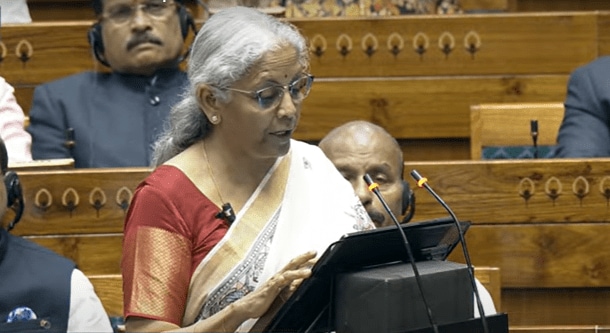In the Union Budget 2025-26 presented by the Finance Minister Nirmala Sitharaman on Saturday, a record-breaking allocation of Rs 6.81 lakh crore for the Ministry of Defence (MoD) has been allocated, marking a significant increase of 9.53% over the previous financial year. This budget reinforces India’s commitment to modernizing its defence forces and fortifying the country’s security infrastructure, with a strong emphasis on self-reliance and technological advancements.
Overall Budget Allocation and Key Sectors
The total allocation of Rs 6,81,210.27 crore for MoD accounts for 13.45% of the Union Budget, the highest among all ministries. This marks a considerable step forward in achieving Prime Minister Narendra Modi’s vision of `Viksit Bharat’ (Developed India) by 2047, which includes equipping India’s Armed Forces with state-of-the-art technologies to face evolving global security challenges.
The allocation has been distributed across several critical segments of the defence sector, focusing on modernization, self-reliance, and welfare of ex-servicemen.
Here’s a detailed breakdown of the key areas:
Capital Outlay: Modernization of Armed Forces
A significant portion of the budget, Rs 1.80 lakh crore (26.43% of the total MoD allocation), has been set aside for Capital Outlay. This represents a 4.65% increase from the previous fiscal year’s allocation and focuses primarily on the modernization of the Armed Forces. Out of this capital expenditure, Rs 1.48 lakh crore is allocated for the acquisition of advanced technologies, weapons, and platforms. Additionally, Rs 31,277 crore is designated for research and development (R&D) and infrastructure development.
A key objective for this allocation is to drive self-reliance in defence manufacturing, with Rs 1.11 lakh crore (approximately 75% of the modernisation budget) earmarked for domestic procurement. Of this, Rs 27,886 crore is specifically allocated for purchases from domestic private industries. This move aims to bolster the private sector’s participation in India’s defence ecosystem, ensuring that the country reduces dependence on foreign suppliers and builds a robust indigenous defence manufacturing base.
The budget also highlights the focus on emerging technologies such as Artificial Intelligence (AI), Machine Learning, Robotics, and Cyber and Space technologies, which are crucial to future-proofing India’s defence capabilities.
Defence Research and Development (R&D)
A 12% hike has been allocated to Defence R&D, with Rs 26,816 crore designated for funding cutting-edge projects. This is a 12.41% increase from the previous year’s allocation of Rs 23,855 crore. A substantial share of this amount, Rs 14,923 crore, will be directed toward capital expenditure, including funding R&D projects that integrate private sector innovation and technological expertise.
The enhanced focus on R&D aims to develop indigenous solutions that will reduce dependency on imports and enhance the self-reliance of India’s defence sector. Through initiatives like the Technology Development Fund and collaborations with private entities, the budget seeks to advance deep technology innovations in areas critical to national security.
Focus on Ex-Servicemen Welfare
The welfare of ex-servicemen remains a priority, with a significant allocation of Rs 1.61 lakh crore (13.87% higher than last year) for Defence Pensions. This provision ensures that the veterans, who have served the nation, receive timely financial support, particularly in the wake of inflationary pressures.
Moreover, the budget allocates Rs 8,317 crore for the Ex-Servicemen Contributory Health Scheme (ECHS), marking a 19.38% increase over last year. This funding aims to ensure the continued delivery of high-quality healthcare services to veterans and their families, underscoring the government’s commitment to their well-being.
Defence Start-ups and Innovation Ecosystem
In line with the government’s push to encourage innovation and self-reliance, Rs 449.62 crore has been allocated for the iDEX scheme (Innovations for Defence Excellence), which supports start-ups in developing technologies for defence. This is nearly three times the amount allocated in 2023, highlighting the government’s increasing focus on fostering the start-up ecosystem in the defence sector. The Acing Development of Innovative Technologies with iDEX (ADITI) sub-scheme will further fund projects aimed at revolutionizing India’s defence capabilities.
Enhanced Allocation for Indian Coast Guard (ICG)
The budget also reflects a substantial increase in the allocation for the Indian Coast Guard (ICG). The ICG’s Capital Budget sees a remarkable 43% increase, with an allocation of Rs 5,000 crore. This increase will support the acquisition of modern equipment such as Advanced Light Helicopters (ALH), Dornier Aircraft, and Fast Patrol Vessels (FPVs). The Revenue Budget for the ICG has also been raised by 12.64%, bringing it to Rs 4,676 crore. This increase will facilitate the Coast Guard’s efforts in bolstering coastal security and aiding in rescue operations.
Strengthening Border Infrastructure
The Border Roads Organisation (BRO), which plays a vital role in strengthening India’s border infrastructure, receives a substantial 9.74% increase, with an allocation of Rs 7,146 crore. This funding will support the construction of tunnels, bridges, and strategic roads in difficult border regions like Arunachal Pradesh, Jammu & Kashmir, and Rajasthan, contributing to national security while fostering economic development in these regions.
